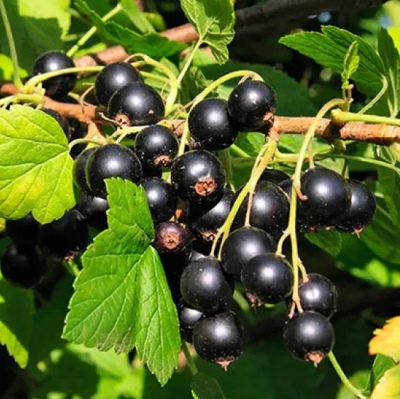
- Ripening terms: mid-early
- Growth type: tall
- Yield: high
- Berry weight, g: 5–7
- Sheet: with a delicate greenish tint
- Berry color: Navy blue
- View: black
- Berry size: large
- Berry shape: rounded
- Skin : glossy, elastic
Currant Black Boomer (translated from English as "causing a stir") has not only an original name, but also characteristics. The berry bush bears fruit more than once a season with large, vitamin, dark blue, currants, pleasant to the taste. Gardeners from various regions of Russia are pleased with its yield, resistance to freezing and various diseases.
Breeding history
The mid-early variety was bred by the Kharkov breeder N.P. Uzenkov by crossing the varieties Chudesnitsa and Selechenskaya - 2.
Description of the variety
Currant Black boomer belongs to the mid-season. Feels great in sunny, protected areas. An upright currant bush is tall, up to 120 cm, powerful, with straight, thick branches and small pale greenish leaves. Begins to bear fruit in June - in the southern regions, from July - in more northern regions. The fruits are large, the number of berries in a bunch is up to 20 pieces with a very high marketability.
Characteristics of berries
Dark blue round berries are similar to grapes, weighing 5-7 grams, round in shape with a glossy, elastic skin, with a dry separation of the berries. Real currants! Ideal for use raw, in canning, confectionery art, in the creation of juices, fruit drinks, sauces.
The variety belongs to the category of well transportable.
Taste qualities
Tasty, dense, fleshy, homogeneous brown pulp of Black Boomer berries is aromatic, quite pleasant, sweet, with a slight sourness. The skin is not hard, smooth.
When consumed raw or frozen, without heat treatment, all trace elements, the taste of summer, vitamin C, fructose, and a wonderful smell are preserved.
Ripening and fruiting
The mid-early variety begins to delight us with delicious berries in the middle of summer. Super-large fruits ripen all at the same time, up to 20 pieces in a bunch. From this, branches can bend under their weight to the ground. With top dressing, timely watering, favorable weather conditions, the crop is harvested twice a season. The variety differs from others in unpretentious care, disease resistance, vitality. Ripe fruits almost never fall off the branches.

Yield
The black boomer is high yielding. 5-7 kilograms of berries are stably harvested from the bush during the season.
Growing regions
Black currant is adapted on the territory of Russia, all regions are suitable for its cultivation. The variety is resistant to various whims of nature.
Self-fertility and the need for pollinators
A good harvest of currants depends on normal pollination with pollen of their own varieties or their own. To get a plentiful ovary, you need to work on cross-pollination. There is only benefit from the neighborhood of currant bushes: the berries will be large, and the yield is high. This can also be facilitated by spraying with a solution of potassium permanganate and boric acid during flowering.
Landing
The currant bush is tall, formed with four branches, the height of which reaches 120 cm.With a large harvest, he needs support. It is better to choose a place for planting that is protected from the wind, sunny, with drained acid soils. In the spring, it is necessary to carry out preventive pruning, removing unnecessary or affected branches.

Growing and caring
Currant variety Black boomer is winter-hardy. The berry bush needs feeding with organic fertilizers, lime solution, granular superphosphate. During the ripening period of the crop, it is good to provide watering 2-3 times a week to preserve the taste of the berries, from drying out the root system. Spring and autumn care is done like any other black currant.




Disease and pest resistance
A feature of black currant is immunity to viral diseases, diseases. In the off-season, the bushes are treated with special biological or chemical agents against pests and ticks.
Resistant to adverse weather conditions
The Black Boomer variety is drought-resistant, tolerant to high temperatures. In winter it is frost-resistant. According to the positive reviews of gardeners, it adapts well in extreme external weather conditions without reducing the yield indicator.

Currant is one of the most favorite crops of gardeners, it can be found on almost any personal plot. In order for the currant berries to be tasty and large, and the bush itself to be healthy and strong, you should properly care for, treat and protect the plant from harmful insects. It is important to recognize the signs of the disease in a timely manner and begin treatment in the early stages of plant damage.










































































